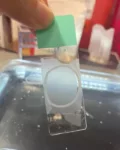Welcome to our FAQ blog post about the Lumea FocalRing. We compiled a list of frequently asked questions about this technology so you can learn how it benefits pathology labs.
What is the FocalRing?
The FocalRing® is a tool designed to reduce scanning failures and rescans commonly associated with poor focal plane definition of small tissue biopsies and cytology samples. It provides a reliable plane of focus for whole slide scanning.
What is the purpose of the FocalRing?
The primary purpose of the FocalRing is to reduce the amount of rescans common with small tissue biopsies and low-cellularity cytology.
What specimen types work with the FocalRing?
The FocalRing is specifically made for small biopsy and low-cellularity cytology slide preparation.
 How does it work?
How does it work?
The FocalRing comes embedded in a block. When ready to use it, section it the same thickness as the tissue or cell structure it will be associated with. Once a section of the ring is on the slide and deparaffinized and cleared, the desired sample (produced at the same thickness) is placed within the ring. The slide then goes through the standard processes to stain and digitize, with the FocalRing providing the plane of focus for whole slide scanning. Book a call with us to learn more specifics about how it works.
How many uses can I get out of one FocalRing?
You can expect about 300 slides out of one FocalRing block if cut on the microtome at 4 microns thick.
Buy the FocalRing today to improve scanning in your lab. See more of our unique tissue-handling tech on our product page.

